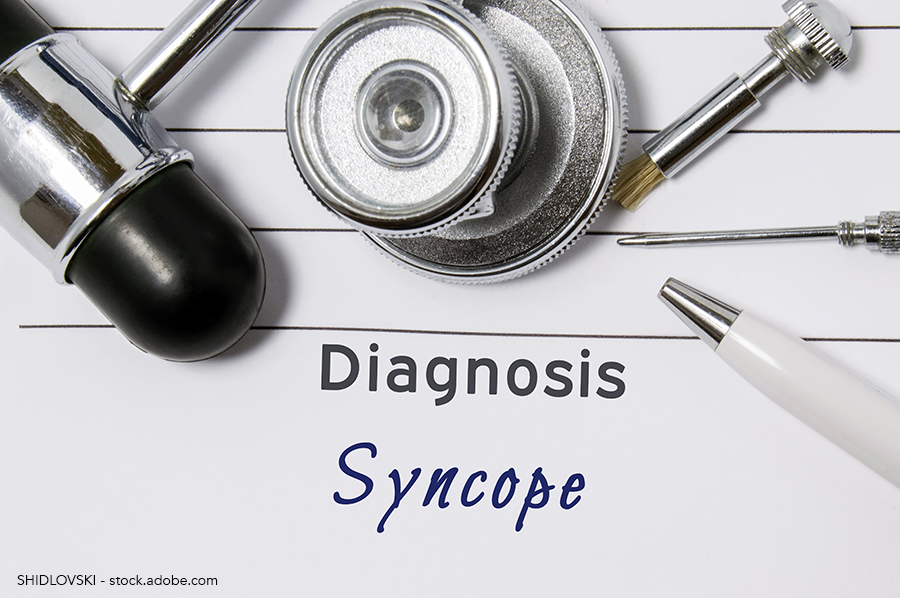 Dr. Daniel Dressler started his evidence-based evaluation of the syncope presentation by polling the audience with a few cases and questions regarding syncope. Before finding out the correct answers, he helped lay the groundwork by defining syncope as a sudden loss of consciousness and postural tone due to cerebral hypoperfusion, which resolves rapidly and spontaneously. He emphasized that this definition is important as it differentiates it from other causes of transient loss of consciousness such as head trauma, seizures, and psychogenic pseudosyncope.
Dr. Daniel Dressler started his evidence-based evaluation of the syncope presentation by polling the audience with a few cases and questions regarding syncope. Before finding out the correct answers, he helped lay the groundwork by defining syncope as a sudden loss of consciousness and postural tone due to cerebral hypoperfusion, which resolves rapidly and spontaneously. He emphasized that this definition is important as it differentiates it from other causes of transient loss of consciousness such as head trauma, seizures, and psychogenic pseudosyncope.
Syncope can be placed into four categories. Reflex is the first category; causes include vasovagal, situational, and carotid sinus syncope, making up 60% of syncope cases. The other three categories include orthostatic, arrhythmia-related, and structural-cardiovascular.
The etiology of syncope can be determined in 45% of cases using history and physical examination alone. Differentiating seizure from syncope can be difficult, but the highest positive likelihood ratio for seizure was tongue biting at 8.6. Jerking motions are common after syncope, occurring in 10% of cases, but just a few jerking motions suggest syncope. Syncope is followed by limb stiffening in 1% of cases. Urinary incontinence actually occurs in equal frequency between syncope and seizure.
Dr. Dressler emphasized the importance of doing orthostatic evaluation in all cases of syncope as a recent study showed 38% of patients did not get this type of testing despite admission for syncope. All patients should have a complete cardiac and neurologic exam, including a cerebellar exam to rule out posterior circulation stroke, as this can be missed.
Dr. Dressler took the time to discuss the Pulmonary Embolism in Syncope Italian Trial (PESIT) published in the New England Journal of Medicine in 2016 as it raised a lot of alarm bells. In this Italian population, 17% of patients admitted with syncope had a pulmonary embolism (PE). What explains such a high rate of PE? This study eliminated low-risk syncope patients and those with non-syncope transient loss of consciousness, such as seizure and head trauma, using a structured approach in the emergency department (ED), with only high-risk syncope patients being admitted. These high-risk syncope patients made up 28% of the patients included in the study. After admission, a simplified Wells’ pulmonary embolism criteria score was calculated, and a D-dimer was obtained. If either was high, the patient was scanned for PE and 17% were found to be positive, with two-thirds of those being found to have large-vessel pulmonary emboli. The bottom line of this study was that only 4% of the ED presentations for syncope after a structured workup had a PE. Subsequent meta-analysis showed a much lower prevalence of PE in patients admitted with syncope at 0.5 to 2.0%. In the U.S., the rate of admission for syncope was 78% whereas it was 28% in PESIT, likely due to a more structured ED workup.
Dr. Dressler shared the pearl that he obtains a D-dimer after admission if the etiology is still unclear, which occurs in about 10% of the patients that he admits with syncope.
The best-validated risk-scoring tool for syncope is the Canadian Syncope Risk Score, which came out in 2016 and identifies patients at risk for serious adverse events (death, myocardial infarction, arrhythmia, structural heart disease, aortic dissection, PE, severe pulmonary hypertension, subarachnoid hemorrhages, or serious condition requiring intervention) within 30 days of ED disposition. Dr. Dressler no longer talks about other scores and uses this one alone in all his syncope admissions. This score suggests that patients with a score of 0 or below can be discharged from the ED, while a score of 3 or higher warrants admission.
In discussing evidence-based tests to order, while greater than 50% of patients with syncope had brain imaging, carotid Doppler ultrasound, or electroencephalogram, the diagnostic yield was only 1.5%. The yield would be 32% if neurologic studies were directed only at patients with neurologic findings on history or physical exams. Exercise stress testing could be considered in exertional syncope, but it has a diagnostic yield of only about 1%. In patients with concern for arrhythmogenic etiology, electrophysiologic studies have a diagnostic yield of 30-60%.
What about echocardiograms? While the 2006 ACC/AHA Guidelines for the Evaluation of Syncope recommended echocardiography as a helpful screening tool if the history, physical examination, and ECG do not provide a diagnosis, or if underlying heart disease is suspected, a 2017 Choosing Wisely article showed that the yield of echocardiograms in these patients is 1% and the cost is $1,500 to $2,000 per transthoracic echocardiogram ($100,000 per new abnormality discovered). The yield of echo in patients with an abnormal ECG is much higher at 17% with a cost per new abnormality discovered of $7,000. The updated 2017 ACC/AHA guidelines now recommend transthoracic echocardiography only if the patient is suspected to have a structural problem.
Key Takeaways
- All patients with syncope should undergo a structured and comprehensive history and physical examination focusing on orthostatic, cardiac, and neurological exams.
- Use the Canadian Syncope Risk Score to rapidly determine a patient’s risk of adverse events and triage to inpatient versus home.
- Admitted patients without a clear etiology for syncope should have a D-dimer test, and if positive, imaging to rule out pulmonary embolism.
Dr. Calderhead is a hospitalist at Corewell Health and an assistant professor in the department of medicine at Michigan State University, East Lansing, Mich.